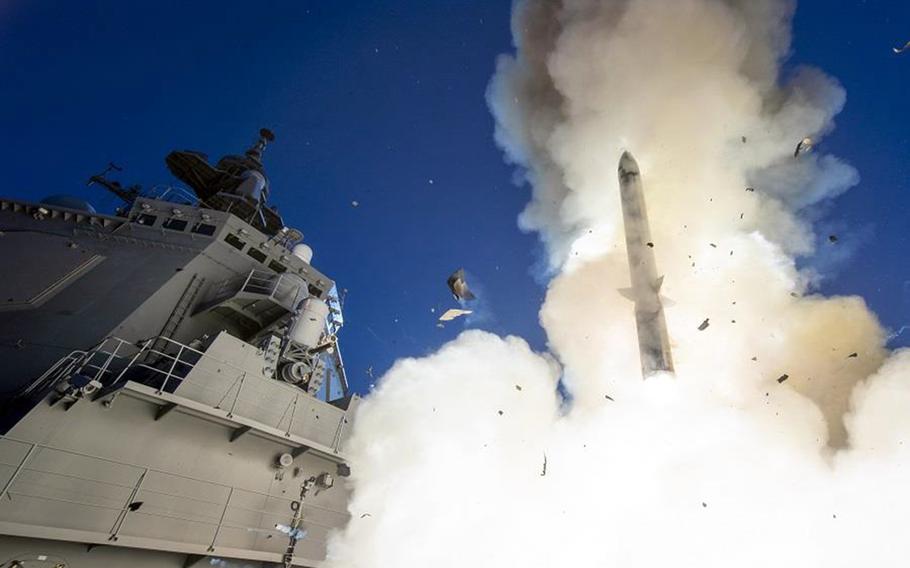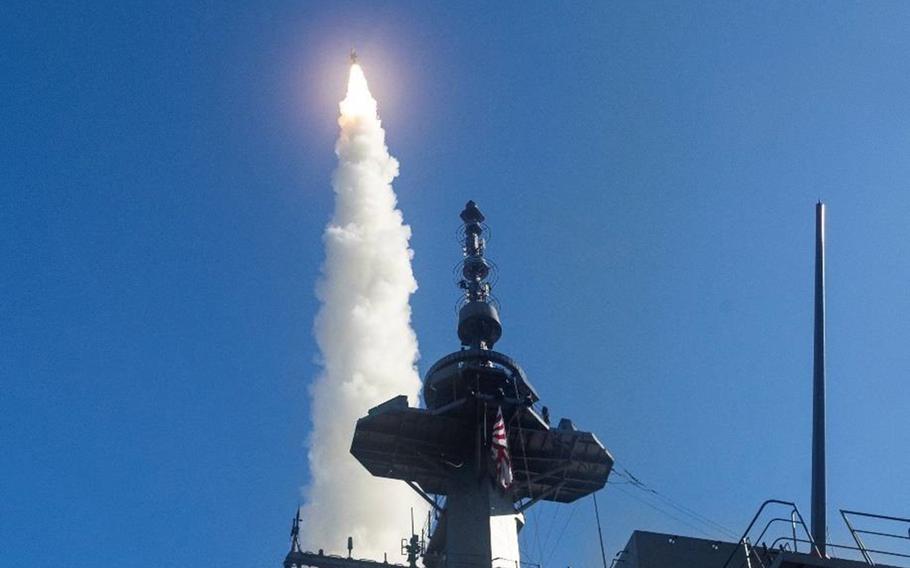
The Japanese destroyer JS Maya launches a missile during testing off Hawaii, Nov. 16, 2022. (Japan Maritime Self-Defense Force)
A pair of Japanese destroyers shot down targets using a new type of defensive missile off Hawaii last week, according to the U.S. Missile Defense Agency.
The live fire was part of a two-week exercise at the Pacific Missile Range conducted by Japan’s newest destroyers — the JS Maya and JS Haguro — in cooperation with the U.S. Navy, according to a Monday statement from the agency, which also participated.
The Maya fired a Standard Missile 3 Block IIA, commonly called the SM-3, that destroyed a target outside the atmosphere that was designed to simulate a medium-range ballistic missile over the Pacific Ocean, the MDA statement said.
The JS Haguro then fired SM-2 and SM-3s at a short-range ballistic missile target and an anti-ship missile target, according to the agency.
The interceptors have larger warheads and rocket motors that allow them to defend broader areas than older weapons, manufacturer Raytheon says on its website.
News of the tests came days after North Korea fired an intercontinental ballistic missile Friday that splashed down in waters less than 150 miles from Japanese territory, according to the South Korean and Japanese militaries.
North Korea has fired more than 65 missiles so far this year. The unprecedented rate of testing has prompted President Joe Biden, South Korean President Yoon Suk Yeol and Japanese Prime Minister Fumio Kishida to pledge to work closely to deter the communist regime.
The live-fire off Hawaii also coincided with the Keen Sword drills in and around Japan involving 26,000 Japanese and 10,000 American troops, 30 vessels and 370 aircraft that ran Nov. 14-19.
The tests demonstrated the capability of the new SM-3 Block IIA missiles, which operate as part of the Aegis missile-defense system, to defeat medium- and intermediate-range ballistic missiles, the MDA statement said.
The tests marked the first time the new missiles have been fired from a Japanese ship, MDA director Vice Adm. Jon Hill said in the statement.
"The cooperative development of the SM-3 Blk IIA by the Japanese government, U.S. government and industry team, and the integration with the Aegis Weapon System on Japan's Ballistic Missile Defense-capable ships, is a remarkable achievement and vitally important in defending against an ever-increasing threat,” he said.

The destroyer JS Haguro launches a missile during testing off Hawaii, Nov. 19, 2022. (Japan Maritime Self-Defense Force)
Japan operates six destroyers equipped with the Aegis system. The country is planning to build two more Aegis destroyers, USNI News reported Monday.
Japan and the U.S. have the capability with the new missiles to defend Guam and islands in the Western Pacific, according to Riki Ellison, founder of the Missile Defense Advocacy Alliance, which lobbies for missile defense, deployment and development.
“Japan clearly demonstrates it has the capability to shoot down anything ballistic at any range from North Korea,” he told Stars and Stripes in an email Monday.
Joint production of the new missiles will greatly improve capacity and lower costs, Ellison said.
“Japan with its ships can defend Tokyo and Japan from Long range … Medium range and Short Range Ballistic Missiles from North Korea and they can defend their ship from cruise missiles while doing that as demonstrated in this test,” he said. “It’s a tremendous win for the defense of Japan and can lead to other sea based and land based platforms on and around Japan that could use the SM3 Block IIA.”
The successful tests are welcome news in the context of recent North Korean missile tests, according to James Brown, an international affairs expert at Temple University’s Japan campus.
“However, I think it's important not to exaggerate what can be achieved by missile defense systems,” he said in an email Monday.
“There remains the concern that even a successful defensive system can be overcome by a saturation attack,” Brown added. “There is also the likelihood that advances in missile defense will only spur North Korea to invest further in efforts to evade such defenses.”